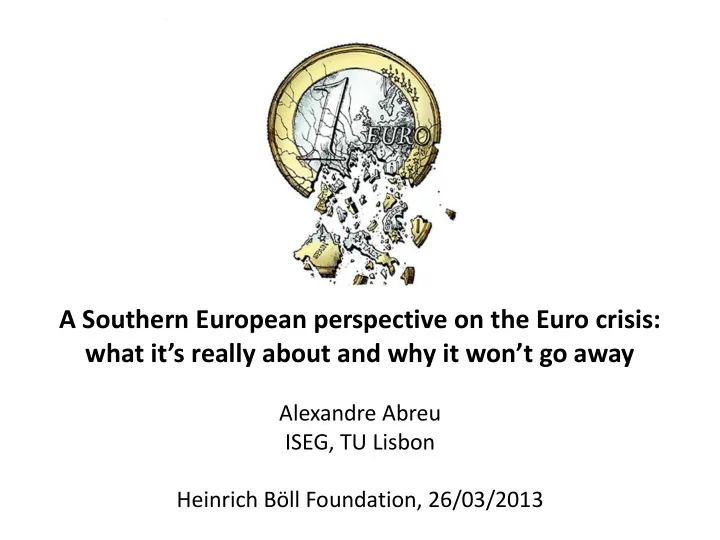

A Southern European perspective on the Euro crisis: what it’s really about and why it won’t go away Alexandre Abreu ISEG, TU Lisbon Heinrich Böll Foundation, 26/03/2013
1. Europe’s “core” and “periphery”: not just about geography
Exports by complexity group for selected Eurozone countries, 2000-2007 (1=most complex; 6=least complex) 0% 10% 20% 30% 40% 50% 60% 70% 80% 90% 100% Germany France 1 2 3 Spain 4 5 6 Portugal Greece Source: Data from Felipe and Kumar (2011): http://www.voxeu.org/article/internal-devaluations-eurozone-mismeasured-and- misguided-argument
2. Building up to the storm
1. Maastricht (1992): nominal convergence, then Euro loss of monetary/exchange rate policy autonomy The Portuguese case: Historical exchange rates: PTE/FFR (blue, left scale) and PTE/DEM (red, right-hand scale) Source: Cabral (2012) “Dívida”: http://www.ffms.pt/xxi-ter- opiniao/artigo/428/divida
…and the Greek one (GRD/DEM): Source: http://www.riskwatchdog.com/2012/05/29/a-new-drachma-would- have-a-long-way-to-fall/
2. Asymmetric shocks aplenty… - EU-Morocco free trade agreement (2000) - China’s WTO accession (2001) - EU Eastern enlargements (2004, 2007) … implying drastically increased competition in the least complex product segments. 3. Wage compression in the core
4. A very “strong” Euro, as a consequence of the ECB mandate.
Between a rock and a hard place: - Sudden opening up to direct international competition in the least complex market segments - Externally over-valued Euro … led to peripheral “low - complexity” industries being systematically undercut. - Loss of key policy instruments - Wage compression in the core … blocked the periphery’s process of industrial upgrade and diversification onto more complex product segments.
The consequence : Current account balance Source: Lapavitsas et al (2010). http://www.researchonmoneyandfinance.org/media/reports/eurocrisis/full report.pdf
A storm in disguise: inflows of capital (EMU) kept these economies afloat, but in a non-sustainable manner International investment position (net external debt) Source: http://www.edmundconway.com/2013/01/the-best-charts-of- 2012/
3. The latent storm breaks out
Enter the 2007-? “global” crisis: - Exports contracted further - External finance dried up … and the latent structural problems turned into an actual recession, which turned into a public debt crisis: - Automatic stabilisers - Bank bail-outs - Counter-cyclical policies in the early stages (widely adopted and encouraged across Europe) - Speculation as self-fulfilling prophecy
The Portuguese case: Currently Government debt as a % of GDP >120%! 120 (2013) 102.3 100 87.8 80 78.8 68.9 67.5 66.6 66 60.8 60 58.1 56.5 53.9 52 MoU with EC-ECB- 40 IMF: May 2011 First austerity 20 package: March 2010 0 2000 2001 2002 2003 2004 2005 2006 2007 2008 2009 2010 2011 Source: Pordata. http://www.pordata.pt/Portugal/Estado+stock+da+divida+directa+em+perc entagem+do+PIB-989
4. The rescue package, why it will not work, and the prospects for the future
The rescue packages (Portugal, Greece): - Large-scale financial assistance temporarily avoiding default - Austerity = “Washington Consensus” conditionality minus currency devaluation The consequences: Government debt keeps escalating recurrent haircuts/default - inevitable (European taxpayers to pay the bill) Widespread unemployment, falling wages domestic market - depressed, bankruptcies, poverty, break-up of social cohesion - Dismantling of Welfare State - Shift in income distribution from labour to capital, increasing inequality - “Treating” the symptom, worsening the underlying causes - Feed-back effects upon European core
So what would be required to avoid permanent decline within the Euro? - Debt service tied to economic performance (esp. employment) - External depreciation of the Euro (change in ECB mandate?) - Expansionary fiscal and incomes policies in the European core - Enhanced policy autonomy in the periphery (trade protection, much more active industrial policy) - Greater intra-European transfers targetting industrial upgrade Is this realistic? Economically, yes. Politically, not at all – and that is a major problem for Europe.
Is the Euro at risk of breaking apart? In the short term, no: • Current governments not interested in leaving (the crisis as pretext); • ‘Disguised’ creditor -led defaults will keep occurring. In the long-run, definitely so: electorates will sooner or later vote into office governments on an “exit” platform. Will the Euro break Europe apart? Hopefully, not. But the current prospects are grim.
Key points from this presentation: • Public debt crisis is a symptom, not a cause • Underlying cause is economic (sudden exposure to direct competition, over-valued Euro, loss of key instruments, policies in the core) • Current levels of public debt impossible to repay anyway – default is inevitable, but who pays the bill is still at stake • Austerity is only making the problem worse, while benefitting vested interests • Absent major changes in policy, the Euro will eventually break apart • and it may bring the EU crumbling down with it.
Thank you. alexjabreu@gmail.com alexabreu@cesa.iseg.utl.pt
Recommend
More recommend